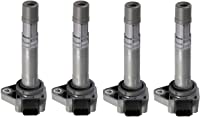In the late 1990s, automobile manufacturers began installing coil packs on car engines, replacing distributors and condensers. Since then many believe that the ignition coils have also been replaced. Nevertheless, the coil pack is an updated version of the ignition coil with state-of-the-art technology and features.
The primary difference between an ignition coil and a coil pack is that an ignition coil acts as an amplifier, creating a high voltage to assist the spark plug to start the engine, whereas a coil pack is a group of ignition coils that come together to supply. Capacity of two cylinders simultaneously. Moreover, the coil pack has proven to be more effective than the ignition coil.
Since they are connected to the ignition system and play the same role, many users have a vague idea about their advantages and disadvantages. This ‘Ignition Coil vs. Coil Pack’ discussion will dispel all your doubts.
Ignition Coil and Coil Pack With a Table
| Comparison | Ignition coil | Coil Pack |
| Function | To provide electric energy to the spark plug | Offer two spark plugs with electric flux |
| Construction | Consists of primary, a secondary winding, and a semiconductor between them | Varies in heat and technology. However, the modern pack is made of epoxy resin s |
| Fuel efficiency | Less effective | More effective |
| Voltage | Require less voltage | Require more voltage |
| Mile coverage | 40,000 to 60,000 miles | 120,000 to 150,000 miles |
| Compatibility | Older automobiles | Modern automobiles |
What Is an Ignition Coil?
The ignition coil is an important part of the ignition system of an automobile. In petrol engines, it helps to create a spark by converting a spark plug from a low-voltage battery to a high-voltage one. In contemporary cars, an ignition system has one ignition coil per spark plug. It has three parts – primary winding, secondary winding, and a dielectric insulator. The primary and secondary windings are covered by an iron core, which strengthens the magnetic flux and makes this magnetic flux ignition coil efficient.
An interesting fact to know:
The first design of an ignition coil was called ‘can style’. The early ignition system was famous during the period 1910-1985 and supplied 12V power with the help of a distributor.
What Is a Coil Pack?
A coil pack is a group of ignition coils that are physically connected and supply power to a cylinder. Since the 1990s, coil packs have been used in place of distributors and condensers. An engine control unit or ECU is in charge of them. In current ignition systems, one coil pack powers two spark plugs. The coil pack can travel from 120,000 to 150,000 miles. The pack can provide cleaner combustion and even work underwater.
Ignition Coil Vs. Coil Pack: Major Differences
Although they serve the same purpose, there are some fundamental differences.
- Distributor: A mechanical distributor is required to supply power to the spark plugs of the ignition coil. Since the coil pack is controlled by a computer, it does not require a distributor. Rather, it must use an electronic sensor to provide power.
- Capacitor Discharged System vs. Flyback System: The coil pack uses a flyback ignition system with numerous coils in modern cars. When the coil pack tries to hold the flux without the aid of a charging current, the stored energy is released at once in this flyback process. Meanwhile, the ignition coil incorporates a capacitor discharge mechanism. In this technology, high-voltage power is stored in a semiconductor capacitor. Since it is equipped with a conventional transformer, it does not require a flyback coil system.
- Work efficiency: Ignition coils were popular before the late 1990s, however, the distributor to which the coil is attached tends to fail prematurely. Also, problems occur when it is wet or cold. On the other hand, coil packs are more reliable, and durable, and can work in cold and wet conditions. Therefore, modern automobile manufacturers are installing coil-pack ignition systems.
Ignition Coil Vs Coil Pack: Pros and Cons
Pros
| Ignition Coil | Coil Pack |
| -Reliable ignition -Smooth performance -Fewer emission -Effective engine control | -More Reliable -Durable -Fuel Efficiency -Requires less maintenance |
Cons
| Ignition Coil | Coil Pack |
| -Compatible for old automobiles -Possibilities of premature failure | -Requires more voltage -Complex electrical system |
To Sum Up
Both the ignition coil and the coil pack have the same function: to provide enough electrical power to the spark plug so that it can ignite. In the ignition system of an automobile, an ignition coil is a single coil, whereas a coil pack is a set of them inside a body. Both parts are skilled in their work but the latter has proved to be more efficient than the previous one. The coil packs are monitored by the ECU system. In fact, we can claim that an ignition coil is somewhat technically backward. If we had to choose one of the aspects of the ‘Ignition Coil vs Coil Pack’ discussion, we would choose the coil pack for obvious reasons and why you can guess.
Related Differences:
- Performance Spark Plugs Vs Regular Spark Plugs
- Spark Plug Vs Glow Plug: Comparison (With Table)
- OEM Plugs Vs Aftermarket Plugs: Comparison (With Table)
- Racing Ignition Coil Vs Stock (With Pros & Cons)
- MSD Ignition Coil Vs Stock (With Pros & Cons)
- Accel Ignition coil Vs Motorcraft – What Are the Differences?

